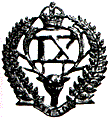
2nd Lieutenant Thomas Marshall Percy GRACE
Clicking on Photo will return to Page E,F,G
GRACE
2nd Lieutenant Thomas Mashall Percy
(Mentioned in despatches).
No. 10/127, 9th (Hawke's Bay) Coy., Wellington Battalion, New Zealand
Expeditionary Force (enlisted as Private).
Born 11th July 1890, in Pukawa, Lake Taupo,
New Zealand
[Birth cert. 1891 215 [Te Awamutu dist. Mar qtr], NZ]
Educated: Blenheim Borough School, Marlborough High School, Wellington
College 1904-5, NZ.
Single; Civil
servant, Post & Telegraph Department, of 99 Coromandel Street, Wellington,
New Zealand.
Next Of Kin: Father; Lawrence Marshall Grace, of Government Buildings
/ Russell Terrace, Wellington, New Zealand.
Photos of Lieutenant Grace are known to exist in the following:
Auckland Weekly News 26 Aug 1915 p38. Canterbury Times 1 Sept 1915 p34ii.
Otago Witness 1 Sep 1915 p42. Wellingtonian War number 1919 p58
